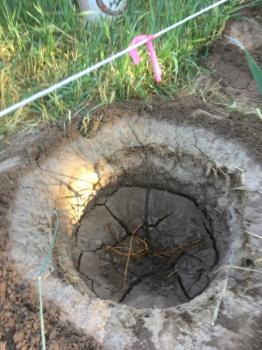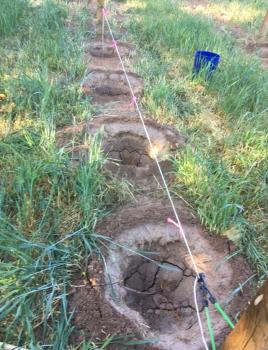April 18, 2020
Spring Planting and Care for Grapevines
A Few Frequently Asked Questions (FAQs)
By guest writer, Dr. Gill Giese, NMSU Extension Viticulture Specialist
How big should the planting hole be?
The hole pictured above is about two feet wide and deep—perhaps a bit of overkill—but the hole should be big enough to accommodate the roots and provide adequate space. This wide hole will help to prevent the dreaded “J-rooting,” when the vine’s longer roots get bent into a J shape to fit the hole and will likely never thrive and will die prematurely.
Use the same soil you dug out to fill the hole, without any amendments. After planting, the graft union should end up about 4 inches above the settled soil line.
Adding fertilizer to the planting hole is not advised when planting bareroot or potted grapevines. Wait 2–3 years until the vine gets established, and add a complete liquid fertilizer only if needed. Always be sure to read labels and follow directions. Remember that the European cultivars like our alkaline (high pH) soils but the American types do not. The latter will likely benefit from a chelated iron product since iron is minimally available in high pH soils.

How do I “line up” the new vines in a row?
An easy way to set up for planting in rows is to use a string secured with bungee cords between line posts, with plastic flagging tape tied at 4 ft intervals to mark where holes should be dug (see photo above). This method allows almost perfect alignment and spacing of newly planted vines without getting in the way of the process.
How cold-hardy are different types/species?
There are many types and species of grapes that can be successfully cultured in the home garden/vineyard. The most vulnerable or least cold-hardy are the European grapes Vitis vinifera, the grape that is most common for wine grapes (Cabernet Sauvignon, Chardonnay, etc.) and many popular seedless table grapes (Thompson Seedless, Princess, etc.). Concord and Niagara are popular "American" grapes and are of the Vitis labruscana species. And then there are hybrids. American types are the most cold-hardy and hybrids are intermediate between American and European types.
Visit the Desert Blooms blog version of this column for a chart showing the variable cold hardiness of various cultivars. Also visit the Los Lunas blog by NMSU Extension Viticulture Specialist Dr. Gill Giese to follow grape research projects around the state. For more information on cultivars recommended for New Mexico, check out the recently revised NMSU Extension Guide H-309: Grape Varieties for North-central New Mexico.

Should I use grow tubes?
Grow tubes are usually white or other colored plastic and a foot or so tall. There are advantages and disadvantages to using grow tubes. Many commercial growers use the tubes to protect the young vines from herbicides they apply to control weeds. This is the main reason for their use in that setting. If you can control the weeds manually without damaging the trunks with weed whackers, the grow tubes are not necessary. Weedeater disease, as it’s called, is a death sentence. Below are some advantages and disadvantages listed for your consideration:
Advantages:
- Increased vine growth via:
- Increased temperatures when ambient temperatures are cool
- Protection from the wind
- Protection from critters
- Protection from herbicide spray (and reduction in labor costs)
- Decreased water use requirement
- Some are reusable
Disadvantages:
- High temperatures may melt wax on grafted vines and could compromise the graft union
- Diseases and insects can proliferate in tubes and be hidden from view. For this reason, some nurseries will not guarantee plants when grow tubes are used.
- Weeds in tubes can be a hassle because they’re hard to access
Guest author Dr. Gill Giese (NMSU Extension Viticulture Specialist) and regular author Dr. Marisa Thompson (NMSU Extension Horticulture Specialist) are both based at the NMSU Agricultural Science Center at Los Lunas.
Marisa Y. Thompson, PhD, is the Extension Horticulture Specialist, in the Department of Extension Plant Sciences at the New Mexico State University Los Lunas Agricultural Science Center, email: desertblooms@nmsu.edu, office: 505-865-7340, ext. 113.
Links:
For more gardening information, visit the NMSU Extension Horticulture page at Desert Blooms and the NMSU Horticulture Publications page.
Send gardening questions to Southwest Yard and Garden - Attn: Dr. Marisa Thompson at desertblooms@nmsu.edu, or at the Desert Blooms Facebook page.
Please copy your County Extension Agent and indicate your county of residence when you submit your question!